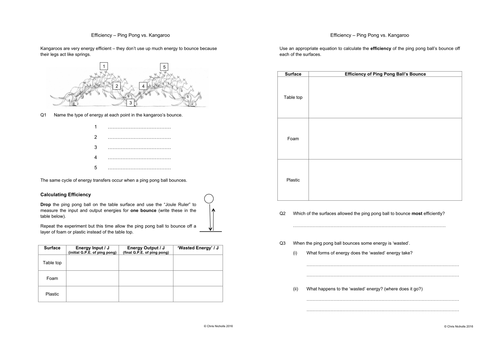




For learners with weaker mathematical skills, core GCSE students or KS3 Physics this introduction to efficiency calculations is fun, focussed and avoids learning objectives being lost in a swamp of mathematics!
Students drop a ping pong ball and work out the efficiency of the bounce using the initial and final height. This is a fairly standard practical for AS Physics; however, working out gravitational potential energies can be arduous and potentially confusing for lower ability students when efficiency calculations need to be the core objective.
This resource includes a worksheet and a template for a 50 cm 'Joule-ruler' (my own invention - simply print out on A3, slice and stick to a half-meter ruler). Specially calibrated for a standard 3.0 g ping pong/table tennis ball, the 'Joule-ruler' can be used to instantly read off gravitational potential energies.
Use with naked eye is fine, however it's also a really neat practical to do with iPhones or similar gadgetry - students can film the bounce in slow motion.
Things you will need:
- 50 cm rulers (metre rulers fine too or wooden batons)
- Clamp stands
- Ping pong/table tennis balls (number these so that any misbehaviour can be held accountable)
- Materials to bounce ping pong balls off (foam and plastic a few mm thick works well)
Original Word document and answer sheet included. Suitable for AQA GCSE Core Science P1 and similar.
Students drop a ping pong ball and work out the efficiency of the bounce using the initial and final height. This is a fairly standard practical for AS Physics; however, working out gravitational potential energies can be arduous and potentially confusing for lower ability students when efficiency calculations need to be the core objective.
This resource includes a worksheet and a template for a 50 cm 'Joule-ruler' (my own invention - simply print out on A3, slice and stick to a half-meter ruler). Specially calibrated for a standard 3.0 g ping pong/table tennis ball, the 'Joule-ruler' can be used to instantly read off gravitational potential energies.
Use with naked eye is fine, however it's also a really neat practical to do with iPhones or similar gadgetry - students can film the bounce in slow motion.
Things you will need:
- 50 cm rulers (metre rulers fine too or wooden batons)
- Clamp stands
- Ping pong/table tennis balls (number these so that any misbehaviour can be held accountable)
- Materials to bounce ping pong balls off (foam and plastic a few mm thick works well)
Original Word document and answer sheet included. Suitable for AQA GCSE Core Science P1 and similar.
Something went wrong, please try again later.
fantastic resource for my lower ability Y9 set. Thank-you.
Report this resourceto let us know if it violates our terms and conditions.
Our customer service team will review your report and will be in touch.
£3.00
